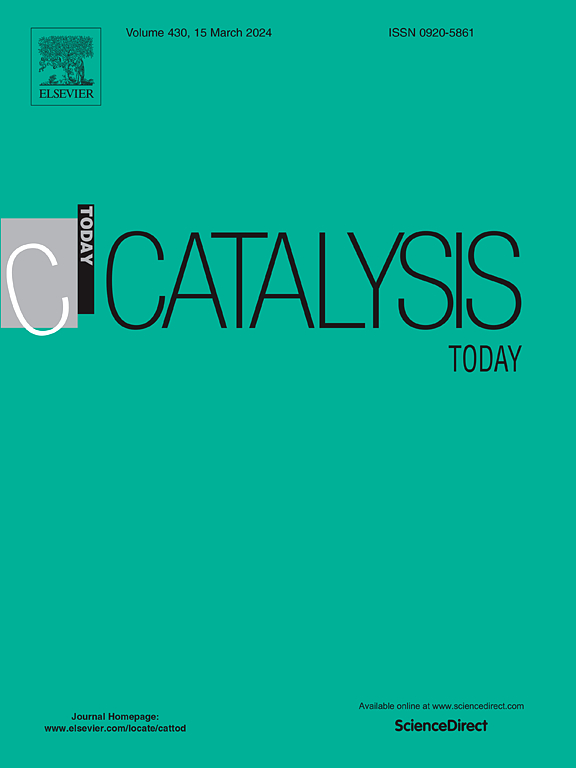Rh/Al2O3 and Pd/Al2O3 three-way catalysts show different thermal deactivation behaviors under real engine-aging conditions
IF 5.2
2区 化学
Q1 CHEMISTRY, APPLIED
引用次数: 0
Abstract
Full-scale honeycomb three-way catalysts (TWCs) coated with Rh/Al2O3 and Pd/Al2O3 were engine-aged under different gas atmosphere and temperature conditions to systematically investigate their thermal deactivation behaviors. The average metal particle size was determined by electron microscope analysis (dEM) and CO chemisorption (dCO). For Pd/Al2O3, dEM and dCO were similar, suggesting the deactivation was simply associated with Pd sintering. The average Pd particle size increased significantly with aging temperature, from under 10 to over 100 nm. The effect of gas atmosphere on particle size was practically negligible. Contrastingly, for Rh/Al2O3 the Rh particle size remained approximately one order of magnitude smaller than Pd, and the temperature dependence was not as noticeable because of a lower sintering rate. Interestingly, dCO and dEM differed substantially depending on the gas atmosphere. Such discrepancy was rationalized by the incorporation of Rh3+ into the Al2O3 surface structure. Most likely, depending on the atmosphere, a strong anchoring effect at the Rh-Al2O3 interface led to preserving highly dispersed metallic Rh nanoparticles on the Al2O3 surface. The TWC deactivation behavior was remarkably different depending on the platinum group metal, Pd or Rh.
Rh/Al2O3和Pd/Al2O3三元催化剂在发动机实际老化条件下表现出不同的热失活行为
采用Rh/Al2O3和Pd/Al2O3包覆的蜂窝状三元催化剂(TWCs),在不同的气体气氛和温度条件下进行了发动机老化,系统地研究了其热失活行为。通过电镜分析(dEM)和CO化学吸附(dCO)测定了平均金属粒度。对于Pd/Al2O3, dEM和dCO相似,表明失活仅与Pd烧结有关。随着时效温度的升高,Pd的平均粒径显著增大,从10 nm以下增大到100 nm以上。气体气氛对颗粒大小的影响几乎可以忽略不计。相比之下,对于Rh/Al2O3, Rh粒度仍然比Pd小一个数量级,并且由于烧结速率较低,温度依赖性不那么明显。有趣的是,dCO和dEM因气体大气的不同而有很大差异。这种差异通过在Al2O3表面结构中加入Rh3+得到了合理的解释。最有可能的是,根据大气的不同,Rh-Al2O3界面上的强锚定效应导致在Al2O3表面保留了高度分散的金属Rh纳米颗粒。TWC失活行为因铂族金属Pd或Rh的不同而有显著差异。
本文章由计算机程序翻译,如有差异,请以英文原文为准。
求助全文
约1分钟内获得全文
求助全文
来源期刊

Catalysis Today
化学-工程:化工
CiteScore
11.50
自引率
3.80%
发文量
573
审稿时长
2.9 months
期刊介绍:
Catalysis Today focuses on the rapid publication of original invited papers devoted to currently important topics in catalysis and related subjects. The journal only publishes special issues (Proposing a Catalysis Today Special Issue), each of which is supervised by Guest Editors who recruit individual papers and oversee the peer review process. Catalysis Today offers researchers in the field of catalysis in-depth overviews of topical issues.
Both fundamental and applied aspects of catalysis are covered. Subjects such as catalysis of immobilized organometallic and biocatalytic systems are welcome. Subjects related to catalysis such as experimental techniques, adsorption, process technology, synthesis, in situ characterization, computational, theoretical modeling, imaging and others are included if there is a clear relationship to catalysis.
 求助内容:
求助内容: 应助结果提醒方式:
应助结果提醒方式:


